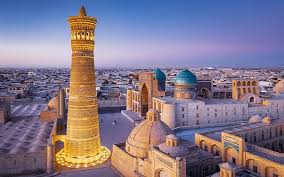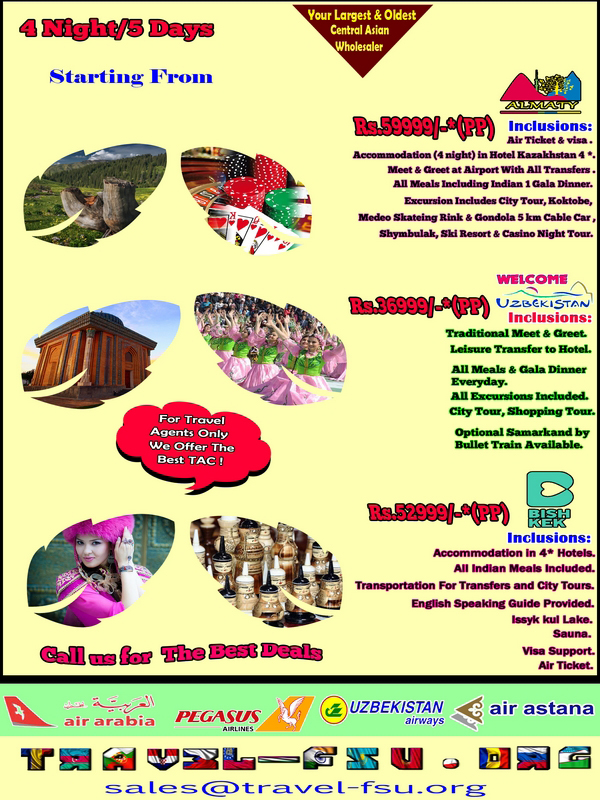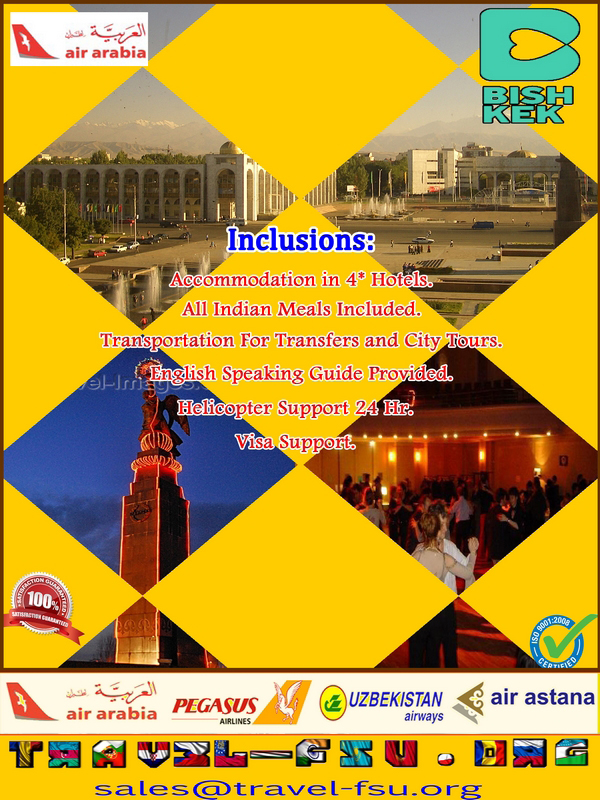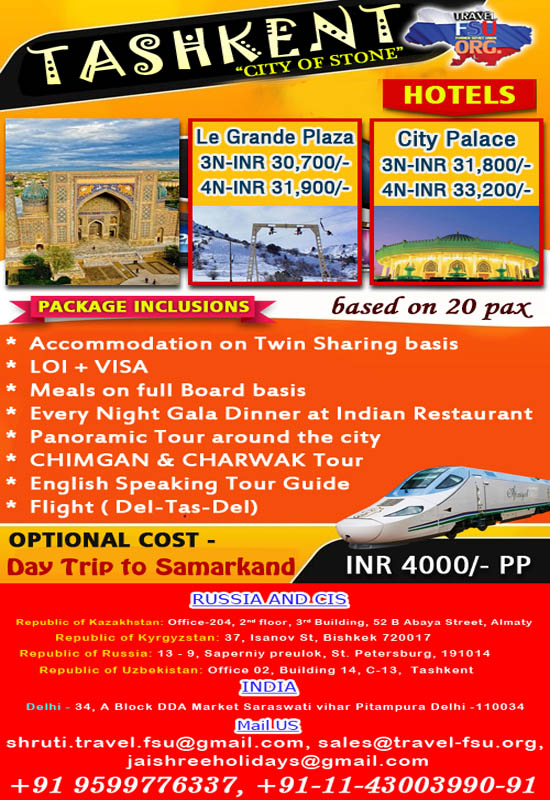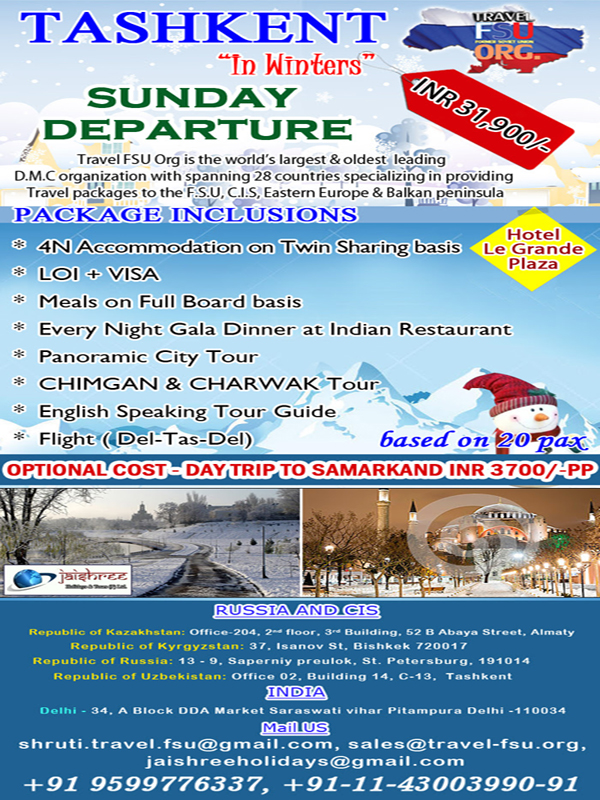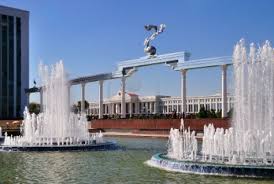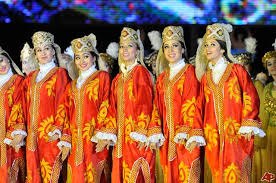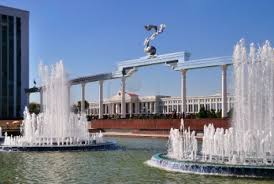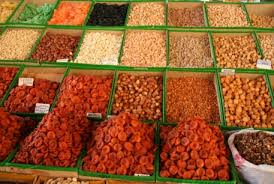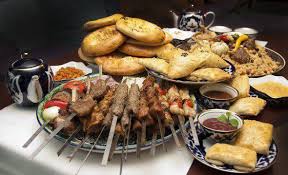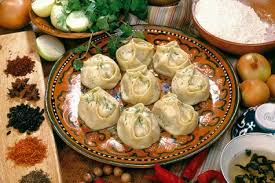The Republic of Uzbekistan one of the largest country in the region, which has a special geographical and geopolitical position in Central Asia with abundance of natural and human resources. Uzbekistan consists of 12 provinces and the Autonomous Republic of Karakalpakstan. Independence and sovereignty of the Republic of Uzbekistan was proclaimed in August 31, 1991. National currency: Sum is the National currency of Uzbekistan. 1 Sum = 100 tiyins (small coin). Notes are in denominations of 10 000, 5000 , 1000, 500, 200, 100 sum.
Geography
Location: Central Asia , south of Kazakhstan and north- east of Turkmenistan.
TERRITORY
Total – 447 400 km2;
Land – 425 400 km2;
Water – 22 000 km2;
LANDSCAPE
Most of the territory of Uzbekistan is occupied by plains (about four fifth of its territory). One of the main – plain is Turanianlowland. To the east and north- east of the country there are ranges of the Tien Shan and Pamir, here – the highest point of the country ( 4643 m). In the north central part of the territory of Uzbekistan is one of the largest deserts in the world – the Kyzyl Kum.
CLIMATE
Majorly sharp- continental. The temperature difference between the seasons is quite significant. Average winter temperature is 6 C below and in July the average temperature rises above 32 C. The amount of precipitation is insignificant, which makes agriculture dependent on irrigation.
NATURAL FEATURES
Uzbekistan`s nature features by a combination of subtropical and continental temperature zones.
The earth, the air, water and fire ( the sun ) have been warshiped in Central Asia since the times of Zoroastrianism urging people in to care about the cleanliness of rivers and the soil.
Population
POPULATION AND LABOR RESOURCES
The population of Uzbekistan is more than 32 million people.
In terms of population Uzbekistan holdes the third place among the CIS countries and 1st among the States of the Central Asia.
Almost 80 % of its population is the Uzbeks . Uzbekistan multiethnic country – it is home to over 100 nationalities where the Russian consist of 5.5 %, Tajiks 5 %, Kazakhs 3%, Karakalpaks 2.5 %, Tatar 1.5%, other 2.5 %. Religious denominations are Muslim 88 % (mostly Sunnis ), Christian Orthodox 9 % and others 3% ( Judaists, Buddhists, Catholics, Protestants etc.)
Uzbekistan, like other Central Asian states, is featured by a relatively ” young” population and a high proportion of people of working age. The share of those below working age in the general population is 39%, of working age – 54 %, of retireds – 7%.
PUBLIC HOLIDAYS
New Year – January 1
International Women’s Day – March 8
Celebration of Navruz – March 21
Memorial Day – May 9
Independence Day – September 1
Teacher’s day – October 1
Constitution Day – December 8
Eid – al- Fitr ( religious festival ) – date varies
Eid al- Adha ( religious festival ) – date varies
INTERESTING FACTS ABOUT UZBEKISTAN
Gold reserves of Uzbekistan are ranked fourth in the world after South Africa, the USA and Russia. And as for the extraction of gold – the second place among the CIS countries after Russia.
Uzbekistan is one of the top five global producers of cotton. Five countries: China, USA, India, Pakistan and Uzbekistan – together produce 65% of the total amount. For Export of cotton Uzbekistan is the third largest after the U.S. and India. More than 75% of the produced cotton fiber is exported.
Uranium reserves of Uzbekistan are ranked seventh in the world after Australia, Kazakhstan, Russia, Canada, South Africa and Ukraine, and the third in the world in its export after Kazakhstan and Australia.
On reserves and production of copper and tungsten Uzbekistan is among the top ten countries in the world.
Natural gas production in Uzbekistan is one of the top ten producing countries of the world and ranks third in the CIS after Russia and Turkmenistan. The gas industry of Uzbekistan is concentrated mainly in the areas of Gazly and Karshi. In 2010, Uzbekistan discovery of new natural gas field near Kosbulak deflection and the North Ustyurt region (Western Aral), as well as the prospective area Ernaza in the Bukhara-Khiva oil and gas region.
According to the total population of Uzbekistan is the third largest country in the CIS after Russia and Ukraine – more than 30 million people. More than low thirds of Uzbekistan consists of plains (Turan lowlands, The Fergana Valley, the Valley of the Amu Darya, Syr Darya, Zarafshan and their tributaries) and third – of the mountains and foothills (foothills of the Tien Shan, Hissar-Alai).
Highest point: Hissar ridge (4643 meters above sea level)
The lowest point depression Mynbulak (-12.8 meters below sea level)
Uzbekistan, along with Liechtenstein is the only countries in the world, which neighbors do not have access to the sea.
The oldest cities of Uzbekistan are more than 2750 years old, and the most famous of them – Samarkand, along with Rome, one of the oldest cities in the world.
On shore of Qashqadarya is located one of the first five latitude stations in the world and its called Kitab. In the spring of 2010 Kitab team at ORI-40 start search for hazardous near-Earth asteroids.
Uzbekistan is the only Central Asian city which subway was built in 1977.
Tashkent – one of the few cities in the world where you can see the starry night sky and it’s possible because of low gas content.
For more information please visit: http://uzbekistan.travel/en/
Transport
As of 2007, Uzbekistans overland transportation infrastructure had declined significantly in the post-Soviet era due to low investment and poor maintenance. Air transport was the only branch that has received substantial government investment in the early 2000s, as airport modernization projects have been undertaken.In the following years, improvements have been made to the surface transport network including the construction of the Tashkent–Samarkand high-speed rail line.
Railways: As of 2008, Uzbekistan had 3,645 kilometers of rail lines, about 620 kilometers of which were electrified. A large percentage of the systems track requires major repair. The main line is the portion of the Transcaspian Railroad that connects Tashkent with the Amu Darya. There are rail links with Kazakhstan, Kyrgyzstan (see Trans-Caspian Railway), Tajikistan, Afghanistan, and Turkmenistan.
Highways: As of 2005, Uzbekistan had 84,400 kilometers of roads, about 72,000 kilometers of which were paved. The road infrastructure is deteriorating, particularly outside of Tashkent. No significant highway projects were underway in 2006. In the early 2000s, U.S. engineers improved some roads around the port of Termez to facilitate movement of humanitarian supplies to Afghanistan.
Airports: As of 2012, Uzbekistan has 53 airports. 33 of them have paved runways, six of which had runways longer than 3,000 meters. The largest of them, Tashkent International Airport, is linked with European and Middle Eastern cities by direct flights of Aeroflot, Lufthansa, Transaero, and Turkish Airlines, and with New York and Los Angeles via connecting flights through Moscow. The national airline, Uzbek Havo Yollari (Uzbekistan Airlines), flies mainly within the former Soviet Union.
Greetings
|
Salom |
|
|
Hello (on phone) |
|
|
Reply to How are you? |
|
|
Anchadan beri korishmadik! (frm) |
|
|
Anchadan beri korishmadik! (frm) |
|
|
Hayir |
|
|
Oq yol! (Happy journey) |
|
|
Ha |
|
|
Yoq |
|
|
Yoq |
|
|
Bilmayman |
|
|
Men sizni tushunayapman |
|
|
Men tushunmayapman (frm) |
|
|
Siz Inglizcha gaplashasizmi? |
|
|
Do you speak Uzbek? |
|
|
Yes, a little |
Ha, bir oz |
|
How do you say ... in Uzbek? |
Ha, bir oz |
|
Reply to thank you |
Arzimajdi |
|
Meni tinch qoying! (frm) |
|
|
Mirshabni chaqiring! |
|
|
Rojdestvo bayramingiz qutlug bolsin! |
|
|
Tugilgan kuningiz bilan! (Тугилган кунингиз билан!) |
